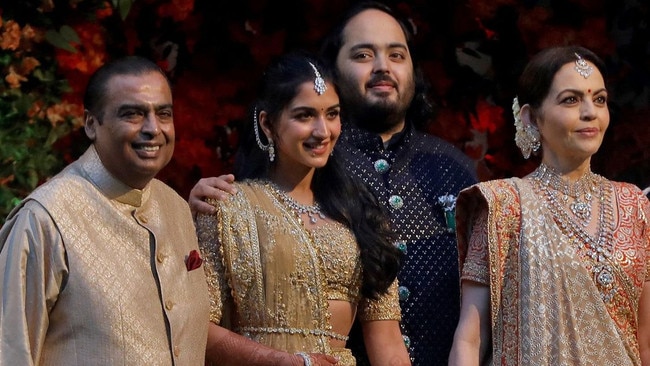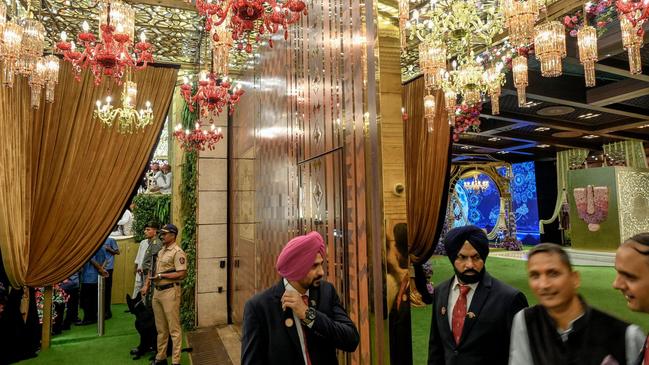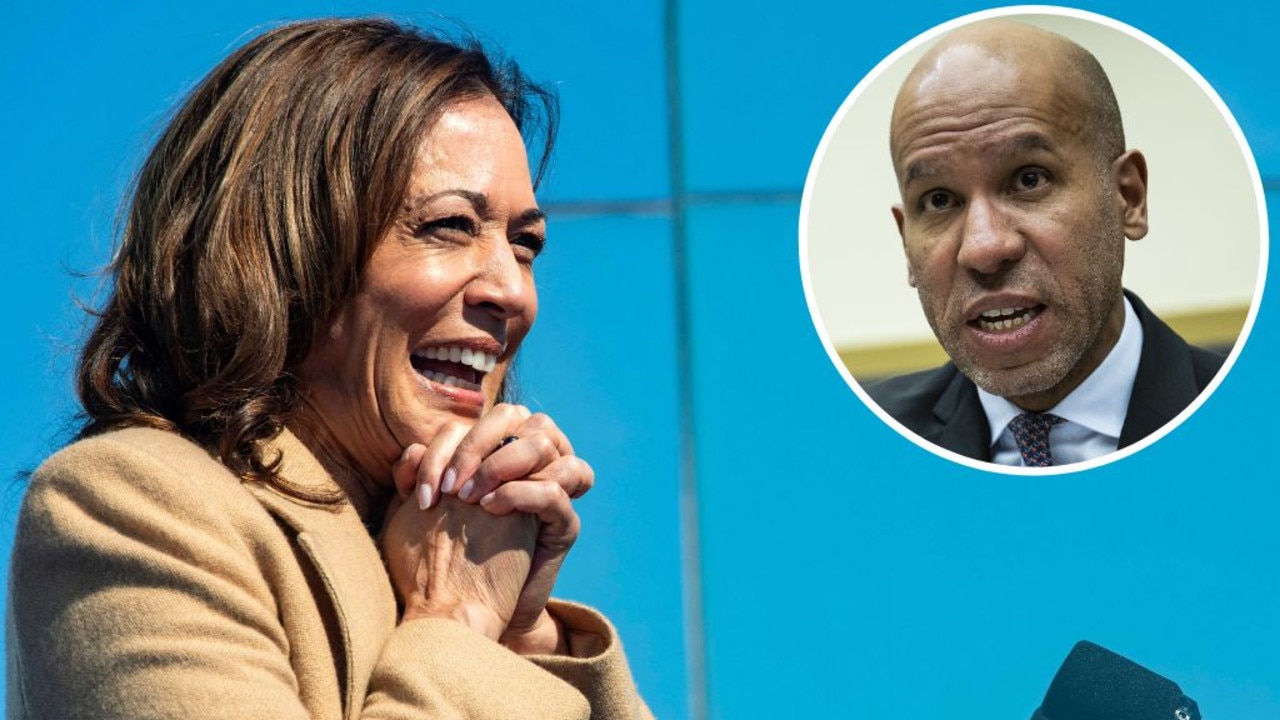Billionaire wedding puts ‘crazy rich Indians’ in spotlight
The over-the-top celebration, with an estimated price tag of more than $140m, is taking place in a fast-growing economy that is creating more billionaires and millionaires.

One of the most lavish weddings in recent years wraps up in India this weekend, after giving the world an eye-popping look at the spending power of a fabulously wealthy billionaire family – the Ambanis.
Anant Ambani, 29, the youngest son of Mukesh Ambani, head of industrial conglomerate Reliance Industries and India’s richest man, is marrying Radhika Merchant, also 29, the scion of another Indian business family. The wedding’s price tag is estimated to be upward of $US100 million (about $148m).

The bride has worn a bespoke Versace dress, a vintage Yves St Laurent cocktail dress and a toga with a 3D-printed aluminium breastplate made by at least 30 people, according to an account Merchant gave to Vogue India.
The groom’s mother has worn a necklace with emerald pendants the size of small bars of soap. Some of the events took place in a glass palace made for the occasion in Jamnagar, the hometown of Reliance, in the western state of Gujarat.
An Ambani wedding may be in a class of its own, but wealthy families like them aren’t as rare as they once were in India.
The country is minting millionaires and billionaires faster than ever, wealth managers and economists say, thanks to a burgeoning economy that is making large businesses richer, while also making it easier to start new ones.

“Today a billionaire is born every month in our country,” said Himanshu Kohli, co-founder of the multifamily investment office Client Associates. “Every 30 minutes there is a millionaire born.”
Modern-day maharajahs
India had fewer than 10 billionaires two decades ago, when Mukesh Ambani and his younger brother first appeared on the Forbes billionaire list after their father, company founder Dhirubhai Ambani, died. Now, the country is the world’s third-biggest source of billionaires after China and the US.
India’s 200 billionaires have a combined net worth of about $US950 billion, according to Forbes.
These modern-day maharajahs rule over India’s economy and some of them increasingly spend in ways that show it, up-ending expectations of a country long seen as one where only thrifty offerings could succeed.
“The key thing is earlier maharajahs had their own territory, land, control,” said Kavil Ramachandran, a professor at the Indian School of Business in Hyderabad who researches India’s family businesses. “Now you have to tell the world ‘I am a maharajah’ and that can happen only through this kind of public statement.”
The Ambanis have flown guests to events, worn ensembles embellished with gold thread and crystals, showcased heirloom jewellery dripping with diamonds, and enjoyed performances from pop stars including Rihanna, Justin Bieber and Katy Perry. At a party that took over an Italian square, the tenor Andrea Bocelli showed up to sing a few numbers.

Select moments from the parties have appeared on Instagram and other social media, including a drone show that created illuminated figures in the sky in Jamnagar, and a video showing Mark Zuckerberg and his wife, Priscilla Chan, admiring a Richard Mille watch worn by Anant Ambani. A spokesman for the company said the watch belonged to an edition with a Koi fish motif. Online watch enthusiasts who closely track what is on Ambani’s wrist estimate the watch’s value at more than $US1 million.
The family has adhered to Indian Prime Minister Narendra Modi’s request last year that rich Indians boost the economy by choosing India over destination weddings overseas – if you don’t count a four-day Mediterranean cruise and masquerade ball in Italy.
A high-end Indian wedding for about 200 people in Europe can run close to $US2 million, said Chetan Vohra, who heads Weddingline, a luxury wedding-planning consulting firm. In the Ambani celebrations, many more guests and events have been involved.
The Ambani celebrations culminate in a wedding on Friday whose guest list, according to Indian media, includes former British prime ministers, as well as global chief executives and a few Kardashians.
Over the weekend, the family will host a number of receptions for visiting guests, followed by a party for thousands of household and personal support staff.

India’s Gilded Age?
India now has some 850,000 millionaires, when measured in U.S. dollars, according to Credit Suisse’s research on global wealth, a fivefold increase compared with a decade ago. The country’s per capita gross domestic product, meanwhile, is only about $2,500.
In a widely cited blog post last year, Saurabh Mukherjea, founder of Mumbai-based Marcellus Investment Managers, described India’s growing ranks of wealthy families as a new “octopus” class whose tentacles suck up wealth from different ventures and investments, and have ties to India’s political class.
The term isn’t meant to be pejorative, said Mukherjea. Instead, it is a metaphor for the ability of some players to take advantage of opportunities arising in India as physical and digital infrastructure knit the country’s economy into a larger canvas for business operations, while also providing room for smaller tech-savvy firms.
Fewer than 1000 firms now account for around 60 per cent to 70 per cent of India’s corporate profits, said Mukherjea. The biggest among them are Reliance, Adani Group and Tata Group, which make money on everything from large, expensive infrastructure projects to consumer retail. At the same time, thousands of small firms in India are unprofitable and struggling to survive, creating a two-track economy.
“We are very similar to where America was in the roaring ’20s exactly a century ago,” said Mukherjea. “Where J.P. Morgan, Carnegie, Vanderbilt, Rockefeller, they had made their fortunes, they were dominating industries, they were – you could argue – messing about with how America was run.”


In America, oil exploration, railroads and highways allowed the economy to flourish. In India, the internet, a mobile payments boom and better airline connectivity are having a similar effect, he said.
Nithin Kamath, 44, and his brother, Nikhil Kamath, landed on the Forbes billionaire list in 2023 thanks to Zerodha, the online discount brokerage firm they founded in 2010. They intended their service for day traders, but then the pandemic came along and many Indians with extra savings from sitting at home decided to dip a toe into the stock market. A new group of individual investors was rapidly born and they turned to Zerodha to do their buying and selling.
“There was this whole generation of fence sitters who were thinking of investing but who had not invested and they jumped in,” said Nithin Kamath, and his company was “at the right place at the right time.”
As for the list, he said, being outed as rich was kind of embarrassing but acknowledged that the rankings could encourage other would-be entrepreneurs.
India’s new investors have in turn helped send the market cap of several companies soaring, making the owners of those companies even richer. India’s billionaires include the makers of electric cables, household paints and a domestically made brand of vodka, Magic Moments.
Anas Rahman Junaid, co-founder of Hurun India, part of a research group based in London, has been tracking India’s rich for over a decade for an annual list of people with a net worth now equivalent to about $US120 million or more. He said recent editions show more people hail from manufacturing, infrastructure and consumer businesses, showing a diversifying economy.

Reliance exemplifies that diversification.
The company first soared thanks to its oil, gas and petrochemicals businesses, but in recent years it has pivoted to new-economy businesses. When guests at the wedding post photos of themselves on Instagram, chances are they will be doing it on Jio, a Reliance-owned data network that dominates India. Most of the final wedding events this month will take part at the company’s Jio World Centre in Mumbai. The company even has a stake in the brand founded by wedding fashion designer Manish Malhotra, who made several of the Indian outfits worn by Merchant.
Mukesh Ambani’s net worth, according to Forbes, jumped to about $US116 billion in 2024, up from $80 billion last year. In that light, the spending on the wedding – whether it is ultimately in the tens of millions or the hundreds of millions – could be viewed as positively frugal.
“Ambani weddings, it is a very small percentage of their net worth,” said Kohli of Client Associates. “They can generate this much wealth in a few days or a few months.”
– Dow Jones Newswires




